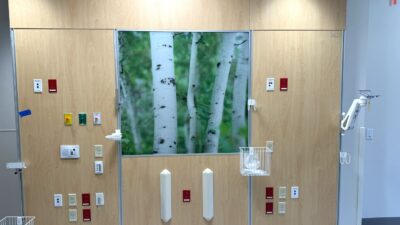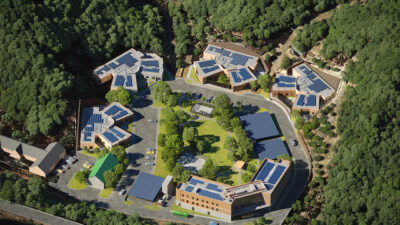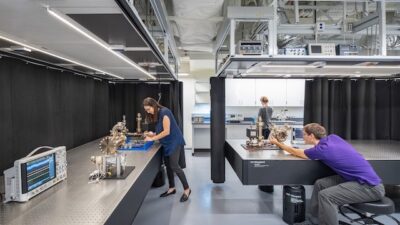Dealing with end-user concerns, using variable speed and evaluating combinations of equipment headline a meeting of the minds on the topic of hybrid chiller plants. CONSULTING-SPECIFYING ENGINEER: What's the latest and greatest with hybrid chiller plant design? ZAK: The emphasis seems to be shifting from a specific piece of equipment to the efficiency of the overall process.
Dealing with end-user concerns, using variable speed and evaluating combinations of equipment headline a meeting of the minds on the topic of hybrid chiller plants.
CONSULTING-SPECIFYING ENGINEER: What’s the latest and greatest with hybrid chiller plant design?
ZAK: The emphasis seems to be shifting from a specific piece of equipment to the efficiency of the overall process. Consequently, today’s systems utilize direct variable flow for chilled water and condenser water, variable-speed compressors, water-side economizer, ice storage and absorption systems—stand-alone or using waste heat. In some cases, the systems are relatively straightforward using chillers, pumps, cooling towers and the like. However, for a relatively small increase in first cost, owners are opting for variable-speed strategies.
At the more elaborate end of system design, we are seeing combinations of off-peak storage, variable flow and absorption units. In general, any single chiller or combination of chillers will work. The issues to resolve are first cost and operating cost, as any energy or cost savings is a direct result of the overall plant efficiency.
MECKLER: Hybrid chillers offer substantial benefits in making combined heat and power (CHP) applications more user-friendly and cost-effective by maximizing waste-heat-driven cooling and heating capacity and thermal energy storage, and reducing electrical demand.
One hybrid offering is indirect utilization in CHP systems of both high- and low-grade waste heat originating from gas-turbine-driven electric generators to power a pair of two-stage absorption chillers and diethylmethanol-tri-ethylene glycol, low temperature absorption chillers for an ice/TES (thermal energy storage) application in combination with electric-centrifugal or screw-type chillers. While a few manufacturers offer expensive absorption chillers capable of accommodating direct turbine exhaust, higher back pressure on turbine exhaust can pose significant power loss. Use of non-volatile, high temperature heat transfer fluids allows indirect extraction of turbine exhaust gas at lower turbine back pressure than what is possible using a heat recovery steam generator. Heat can initially be made available to a two-stage absorption chiller by cascading followed through the building space and domestic hot water systems prior to recirculating to a low pressure drop via a high log mean temperature difference heat extraction coil located in the turbine exhaust ductwork.
SPANSWICK: Addressing the issue of complex calculations necessary for determining the best hybrid plant operating strategy, new cost-analysis software programs are user-friendly. They can quickly analyze multiple variables and help narrow equipment selections. These programs can also perform a sensitivity analysis to show the effect of fluctuating energy costs and help determine, for example, the crossover points to switch from electric to steam chillers.
Advances have also been made in the packaging of non-electric chillers—with more compact systems that require less equipment room space—as well as integrated controls that simplify plant operation. For example, new steam-turbine-drive chillers can be installed with the steam condenser mounted on top, rather than on the floor, for a footprint comparable to an electric-drive chiller of the same tonnage. New, integrated controls with a graphic user interface also simplify startup and operation.
CSE: Why go hybrid?
CLARK: Owners and designers who are inclined to consider state-of-the-art and lowest life-cycle cost facilities will lean toward not only hybrid plants, which can lower operating costs, but also variable-flow pumping and variable-speed drives which do the same. It is a natural extension of the concept to maximize efficiency and cost.
CSE: How do you best meet the demand for greater efficiency?
SPANSWICK: The drive to ever higher efficiencies is requiring variable-speed centrifugal chillers. The inherent characteristics of non-electric drive chillers provide variable speed as an integral feature. Optimizing chiller speed at off-design conditions, which is about 99% of the time, delivers the best real-world energy performance.
Variable-chiller water pumping schemes are also receiving a lot of attention at the moment. Provided that the chiller is operated within design parameters, variable-chilled water can be managed with any well designed microprocessor control system without any problems. Although some systems employ variable-speed condenser water flow, this is in fact the wrong design approach. Since the chiller has the largest system energy consumption, maximizing efficiency by keeping high flow through the condenser during non-peak periods gives the highest overall operating efficiency.
MECKLER: I believe system, not chiller operating efficiency, and its overall effect of annual energy use cost, appears to be the principal decision driver. Consequently, pumping energy use must also be considered. Where campus-type chilled water distribution systems are required, variable-flow chillers, for example, may offer greater overall energy savings due to lower pumping requirements at low to moderate seasonal loads. Where both chilled and condenser water are distributed from central chiller plants and cooling towers, the decision may depend upon whether or not the cooling tower is configured for free cooling. Such systems take advantage of outdoor temperatures below 60°F and benefit buildings which require 24/7 operation: hospitals, manufacturing plants and the like. Where absorption chillers are part of a hybrid mix, they are generally unable to operate at the lower condensing water temperatures generated by tower-free cooling, and require additional controls when combined with electric vapor-compression chillers being served from a common cooling tower. Gas engine-driven vapor-compression chillers, if part of the hybrid mix, can also benefit from tower-free cooling. Additionally, since cooling towers must operate with minimum flow coverage, variable-speed condensing water systems may not afford hybrid chiller plants as much advantage as two-speed or variable-speed tower fans.
CLARK: The use of variable-flow pumping will depend on the configuration of the chilled water distribution system and any connection to an existing plant or distribution system. Variable-flow pumping is another factor that can increase the complexity of a chiller plant operation.
CSE: How do explain the benefits of hybrid chiller plants to an end user?
CLARK: Hybrid chiller plants can provide flexibility in the choice of fuels and energy sources. Even though it’s a given that future energy costs are going to be higher, the relevant cost between gas and electricity will vary. Therefore, it is advantageous to provide the owner with the flexibility to determine which fuel source is the most economical for current operation.
SPANSWICK: Depending on local energy costs and rate structures, a combination of electric and non-electric chillers—i.e., a hybrid chiller-plant—can provide lowest life-cycle cost. This is possible because the most economical source of energy can be matched to the load profile of the facility or campus. A hybrid plant also provides some redundancy in the event of an unplanned chiller shutdown or the unexpected interruption of an energy supply.
MECKLER: Hybrid chiller plants require careful planning for flexibility in daily and seasonal operation. Sequencing lead-lag combinations of gas or waste-heat-fired absorption and gas engine, or turbine-driven vapor-compression chillers and electric chillers can be challenging when annual owning and operating cost or life cycle savings are estimated. The key to maximizing potential savings over comparable capacity of all gas or electric chiller plants requires close and timely 24/7 monitoring and responding to real-time comparative gas or electric utility cost opportunities. This requires state-of-the-art system control features, with plant operators receiving more hands-on training than presently provided following commissioning. End users must become better informed about comparative risks and benefits by their consultants and be committed to ongoing operator training after construction.
CSE: What kinds of concerns do end users generally raise?
ZAK: The two most repeated concerns are the technical sophistication level of the operating staff and the perception of excessively high maintenance costs. In most cases, training the staff and providing the owner with typical annual maintenance costs for plants of a similar nature have resolved these anxieties.
CLARK: End users perceive added complexity to a hybrid chiller plant, as the plant operator has more decisions to make regarding fuel selection and scheduling. However, there really isn’t a significant increase in the complexity of a hybrid plant. As mentioned, proper operator training and plant commissioning can offset these concerns.
There is also a stigma, based on historical design solutions, that chillers in a central plant should be the same type and size. There are good reasons for that type of design solution. However, this is a changing world and we have to adapt to it. The installation of chillers with different capacities and energy sources truly gives the plant operator more opportunities to operate the plant efficiently.
Another issue might be the concern that if an end user is relying on gas-fired chilling to offset peak demand costs, a loss of alternative fuel equipment might expose the facility to substantial electrical demand costs. If this is an issue, the use of a TES with the plant can offset these concerns.
SPANSWICK: First cost on any project is a concern. If the cost of electricity is sufficiently high, a non-electric-drive chiller could offer a lower life-cycle cost, despite its higher capital cost. Controlling energy costs, especially during peak hours, can provide exceptional energy savings, which will rapidly offset the first cost of the equipment.
Does it require multiple energy contract negotiations? Utilizing excess steam during the summer months increases the efficiency of the boiler when on-site steam usage would normally be greatly reduced and does not require an energy source beyond what is already on-site. A gas-engine-drive chiller may require an additional energy contract, but the peak shaving of electric energy costs would more than offset that cost.
MECKLER: End users can differ substantially, depending upon their business model and profit goals. The key to a successful relationship between end users and their A/Es or design-build contractors is getting such understandings on the table as soon as possible and making sure that budgetary costs and comparative projected savings are realistic. If operators are not sufficiently trained or if controls are poorly planned, hybrid chiller systems might be “dumbed down” so that their inherent advantages in responding to gas or electric price breaks are lost. Consultants must begin to think like their end-user clients and be prepared to level with them about their assumptions before, not after, construction commences.
CSE: What factors determine whether to go with absorption or electric, or perhaps a combination of the two, for peak shaving?
CLARK: The factors to be considered include:
-
Current energy costs, including electrical demand charges and time of day charges.
-
Uncertainty of future energy costs and potential future changes in the relative costs between gas, oil, electricity and in some cases, coal.
-
The sophistication of the end user and the willingness of the plant operators to embrace new chilled water plant configurations.
MECKLER: I would add the following to that list:
-
Is the end user building for personal use, for long-term or for short-term speculative investment?
-
What is the construction budget?
-
How do area utility rates compare?
-
What utility incentives, if any, are available for hybrid vs. comparable capacity for all gas or electric chiller plants?
-
How would a substantial spike in foreseeable gas or electric rates or service interruptions due to insufficient capacity impact cost savings projections for any given combination of the two for peak shaving?
The best engineering skills to optimize any given combination can be correct today and wrong tomorrow unless the above questions are answered first.
SPANSWICK: Absorption chillers, as one choice, can be driven by hot water or steam, or can be direct-fired with natural gas. Gas engine-drive and steam turbine-drive centrifugal chillers are also available, both with inherent variable-speed capabilities. Large-tonnage electric chillers are offered in centrifugal and screw-compressor models and electronic variable-speed drives are commonly used with electric centrifugals.
In general, if the cost of electricity is sufficiently high, relative to the cost of hot water, steam or natural gas, a non-electric chiller could offer a lower life-cycle cost, even if it carried a higher capital cost and lower integrated part load value. This is quite possible in scenarios with electricity demand charges—possibly coupled with ratcheted rates—or an RTP rate structure. In these scenarios, a non-electric chiller could be an ideal way to reduce power consumption precisely when electricity is most expensive.
Low-cost steam or hot water may also be one of the outputs of an on-site power-generation plant, often installed as a means of lowering peak demand. Or, favorable natural gas pricing may be available, depending on location and volume used. These situations would also support the efficacy of a hybrid plant.
Participants
Ken Clark , P.E. , Principal and Project Manager, Burns & McDonnell, Kansas City, Mo.
Milton Meckler , P.E., CPC , President, Design Build Systems, Los Angeles
Ian Spanswick , Product Marketing Manager, York International, York, Pa.
Pete Zak , P.E. , Principal, M/E/P Group Manager, Graef, Anhalt, Schloemer & Associates, Milwaukee
Hybrid Chiller Plants: Code Check
When writing those hybrid chiller plant specs, among engineers’ biggest concerns is having an awareness of local air quality and emissions regulations.
Along those lines, Ian Spanswick, product marketing manager, York International, York, Pa., points out that geographic regions are creating and enforcing stricter emission codes for gas-burning equipment, with the Northeast and Southwest leading the pack.
Taking a look at the International Mechanical Code, Ken Clark, P.E., principal and project Manager, Burns & McDonnell Engineering, Kansas City, calls attention to a number of issues, such as the facts that:
There have been some changes in requirements for refrigerant detection systems.
There are still code issues with “open-flame-producing devices and/or hot surfaces in refrigerant machinery rooms.” This could be a consideration with a direct gas-fired chiller used in the same room with an electric centrifugal chiller.
There are also emergency signage issues in machinery rooms with refrigerants and requirements for the remote control of equipment.
Of course, these points are just the tip of the iceberg as the diligent engineer will naturally research the issues pertaining to a particular project much more thoroughly.



